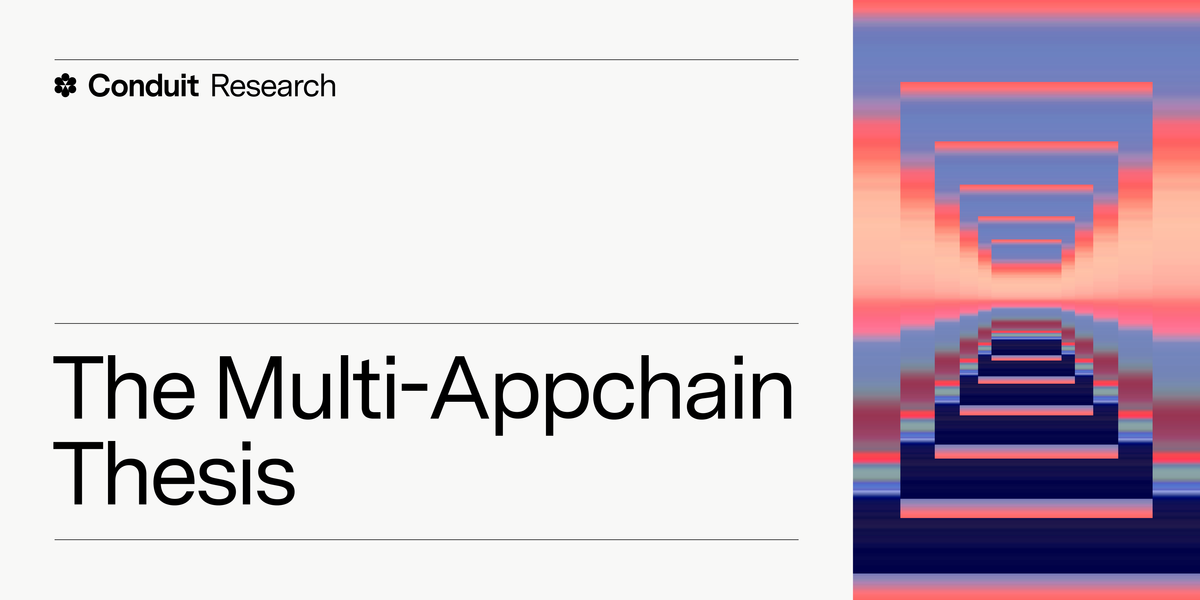The Multi-Appchain Thesis: Why The Meaning of Multichain Is Changing
Multi-appchain is the new multichain.

The rollup-centric roadmap calls for us to scale Ethereum by building rollups on top of L1. Under these conditions, most people believe that apps will go multichain, meaning they’ll deploy on multiple rollups to reach the most possible users. Many apps have pursued this strategy already — Uniswap for example is deployed on chains like Optimism, Arbitrum, Zora, and more.
However, we believe that the current understanding of multichain will be inverted as apps hit hypergrowth. Instead of one app being deployed on many chains, the strategy will be for each app to deploy its own network of dedicated appchains. We refer to this paradigm as multi-appchain — many chains serving one app, not the other way around.
Why multi-appchain? Dedicated block space and throughput
Apps will embrace appchains and then multi-appchains for the same reason we have rollups in the first place: There isn’t enough throughput. When the volume of transactions, users, and apps became too much for Ethereum, we turned to rollups to lighten the load and process more activity off of Eth1.
Similarly, when apps operating on shared blockchains — Ethereum mainnet, Ethereum L2s, other L1s, etc. — hit scaling barriers, they’ll build their own appchain rollups to get dedicated blockspace while still maintaining easy bridging access to the rest of the Ethereum ecosystem. Appchains also allow those apps to customize the rollup to their own specific use case, and take gas fees as revenue rather than pay them out as blockspace rental costs.
Uniswap is the biggest domino to fall so far with last month’s announcement of Unichain. Instead of fighting for blockspace with everyone else, Uniswap will get its own chain, complete with 250 millisecond block times, interoperability with other Superchain rollups, and TEEs from Rollup-Boost — these are the kinds of functionalities you get to choose when you build your own chain from the ground up.
But eventually, the biggest and most compute-intensive apps will find that a single appchain isn’t enough for them. Proof of Play ran into that earlier this year. Even with a dedicated rollup, Proof of Play had to regulate the number of concurrent users for its fully onchain Pirate Nation game. The solution was to launch a second rollup and become the first multi-appchain game.
Crunching the numbers on the need for multi-appchain
The need for multi-appchain becomes apparent when we compare today’s rollups with the centralized alternatives they compete against.
Let’s go back to Unichain.
Unichain will have 250 millisecond block times and can process a maximum of 30 MGas per block. That’s a total of 120 Mgas/s, which translates to a maximum of roughly 5,700 TPS — an impressive number for a DEX. But Uniswap isn’t competing against just DEXs. In the long term, Uniswap should also be competing with CEXs, which have the unique advantage of processing swaps offchain, giving them much higher throughput.
What will that competition mean from an infrastructure standpoint?
Binance, the biggest CEX, can process 1.4 million TPS to Unichain’s 5,700. That means Uniswap would need roughly 246 Unichains to match Binance’s throughput.
We’ll acknowledge a few caveats: Will Unichain’s performance improve beyond 120 MGas/s? Most likely yes. And is Uniswap competing with CEXs like Binance purely on performance? Of course not. Its decentralization, trustlessness, and support for infinite tokens are also selling points. But performance impacts UX, so the point stands: One Unichain won’t be enough for Uniswap to compete with Binance on performance.
The same goes for other major rollups too. We can look at examples on Conduit.
What would it take for Proof of Play to compete with a big web2 game like Clash of Clans on performance? Proof of Play can reach 10,000 concurrent users running two Conduit G2 chains in its multi-appchain. Clash of Clans can reach 4 million concurrent users. So, Proof of Play would need 800 chains in its multi-appchain to match that. If and when we reach Gigagas, Proof of Play would need 80 chains.
Zora is building crypto’s answer to Instagram, complete with NFT minting that empowers content creators to get paid. Zora averages roughly 29,000 daily active users (DAUs) – meaning users who actually transacted on the chain – over the last three months, at an average of 1.2 MGas/s. With a G2 chain running at 100 Mgas/s, Zora could support roughly 242,000 DAUs, and 2.4 million at Gigagas. Instagram has 500 million daily active users. If we assume 10% of those users are actually posting or commenting as opposed to just viewing (in order to make the Zora DAUs comparison more apples to apples), that would mean Zora needs roughly 413 G2 chains to compete with Instagram, or 41 Gigagas chains.
This is all back of the envelope math, but directionally, the point is clear: If we’re really going to onboard billions of users and replace the centralized internet with a decentralized version running on Ethereum rollups, the biggest onchain apps will need to go multi-appchain.

